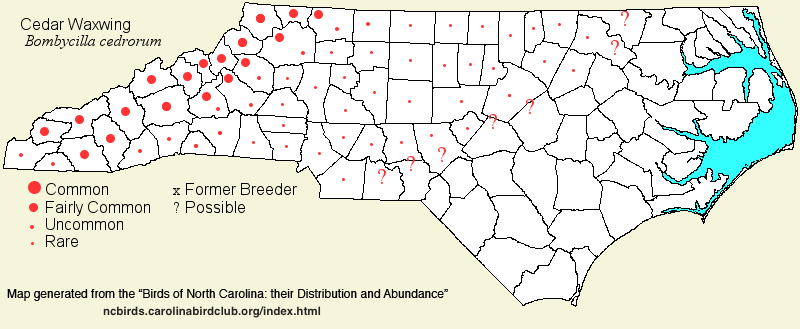 |  |
|
Cedar Waxwing - Bombycilla cedrorum Sole representative of BOMBYCILLIDAE in NC | Search Common: Search Scientific: |
|
|
|||||||
| General Comments | The Cedar Waxwing is a very unconventional bird. Its movements for much of the year are somewhat unpredictable, depending on where considerable volumes of berries are present. Even in the breeding season, they can seemingly nest about anywhere in North Carolina, though most of the birds in the state nest in the mountains. Much larger numbers are present in winter than in summer, and flocks often number 50 or more birds. In the breeding season, they tend to nest in open woods and borders, or scattered trees, even in yards; White Pines are favored nesting trees. They do not feed on berries in summer, but at other seasons they roam the countryside -- usually in open woods, yards, and other sites where hollies, Red Cedars, and other berry-bearing trees (less so shrubs) are found. | ||||||
| Breeding Status | Breeder | ||||||
| NC BRC List | Definitive | ||||||
| State Status | |||||||
| U.S. Status | |||||||
| State Rank | S4B,S5N | ||||||
| Global Rank | G5 | ||||||
| Coastal Plain | Winter resident, and sparse and very erratic breeder. Generally common over the entire region, but as it occurs in flocks, numbers can be a bit unpredictable. Rare in summer, probably mainly as a visitor, over much of the region (even along the coast), with a few confirmed nestings, even in coastal counties. Such nestings are one-time-only occurrences and should not be construed to indicate the sites lie within the consistent breeding range. Mainly mid-Sep to mid-May, and scattered into early Jun; many records from Jul-Sep. Peak counts: | ||||||
| Piedmont | Winter resident, and sparse summer resident (breeder). In migration and winter, generally common, but in flocks. Uncommon into early summer (Jun), but rare in Jul and Aug; breeding is rare and erratic (seldom in the same site from year to year). Most impressive was a count of 33 birds in Tanglewood Park (Forsyth) on 20 Jun 1985; this represented eight nesting sites and 17 juveniles. Mainly late Sep to mid-May, and not rare to late Jun. Peak counts: | ||||||
| Mountains | Permanent resident, with considerable migratory movements. As a breeder in summer, generally fairly common across the entire elevation range, even into the spruce-fir zone; probably less common at the lowest elevations (below about 2,000 feet). In winter, quite erratic from week to week; generally uncommon to fairly common over much of the region. Peak counts: | ||||||
| Finding Tips |
Though often common in winter downstate, it could be missed in a day of birding because it occurs in flocks. However, they would be hard to miss over a several-day period. *** | ||||||
| Attribution | LeGrand[2024-11-06], LeGrand[2023-03-27], LeGrand[2016-12-22] | ||||||
| NC Map Map depicts all counties with a report (transient or resident) for the species. | Click on county for list of all known species. |
| NC Breeding Season Map Map depicts assumed breeding season abundance for the species. |  |